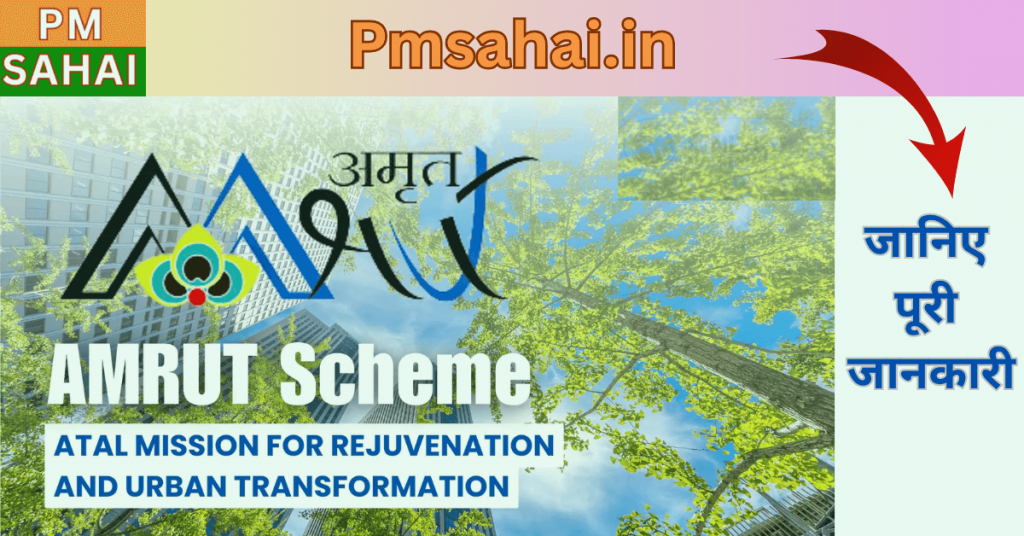AMRUT Yojana 2025: India’s urban landscape is undergoing a significant transformation, thanks to the Atal Mission for Rejuvenation and Urban Transformation (AMRUT) Yojana. Launched in 2015 and revitalized in 2021 as AMRUT 2.0, this ambitious initiative aims to provide universal access to water supply and sewage services, rejuvenate water bodies, and promote a circular economy of water. With a focus on sustainable urban development, AMRUT 2.0 is set to reshape the future of urban India by 2025.

What is AMRUT 2.0?
AMRUT 2.0 is a comprehensive urban development scheme approved by the Union Cabinet with an indicative outlay of ₹2.77 lakh crore for the period 2021–26. The mission’s primary objectives include:
- Universal Water Supply: Providing household tap connections to all 4,378 statutory towns, targeting 2.68 crore connections.
- Sewage and Septage Management: Ensuring 100% coverage in 500 AMRUT cities, aiming for 2.64 crore sewer or septage connections.
- Water Conservation and Reuse: Promoting rainwater harvesting, rejuvenation of water bodies, and recycling of treated wastewater.
- Urban Green Spaces: Developing parks and green areas to enhance the quality of urban life.
- Technology-Driven Governance: Implementing a robust technology-based portal for monitoring and geo-tagging projects.
Key Features and Innovations
Circular Water Economy
AMRUT 2.0 emphasizes the principles of a circular economy, focusing on the conservation and rejuvenation of surface and groundwater bodies. The mission promotes the reuse of treated wastewater, aiming to meet 20% of water demand through recycled water.
Pey Jal Survekshan
To encourage competition among cities and improve urban water services, AMRUT 2.0 introduces the ‘Pey Jal Survekshan.’ This initiative benchmarks cities on various parameters, fostering a spirit of excellence and accountability.

Public-Private Partnerships
The mission mandates that 10% of projects in cities with populations over one lakh be implemented through Public-Private Partnerships (PPPs). This approach aims to mobilize market finance and bring in leading technologies in the water sector.
Capacity Building and Reforms
AMRUT 2.0 focuses on enhancing the financial health and water security of Urban Local Bodies (ULBs). Key reforms include reducing non-revenue water to less than 20%, rejuvenation of water bodies, and reforms in property tax and user charges. ULBs are incentivized for accomplishing these reforms.
Progress and Achievements
As of now, AMRUT 2.0 has made significant strides:
- Over 1.1 crore household tap connections have been provided
- 85 lakh sewer and septage connections have been established.
- 6,000 Million Liters per Day (MLD) sewage treatment capacity is being developed, with 1,210 MLD already created and provisions for the reuse of 907 MLD treated sewage.
- 1,820 parks covering an area of 3,600 acres have been developed, with another 1,800 acres under greening.
- 1,700 flooding points have been eliminated, improving urban resilience.
Regional Impact: A Case Study from Surat, Gujarat
In Surat, Gujarat, AMRUT 2.0 has led to the development of new water supply infrastructure and the rejuvenation of existing water bodies. The city has implemented rainwater harvesting systems and upgraded its sewage treatment plants, contributing to improved water quality and availability. These initiatives align with the mission’s objectives of water conservation and sustainable urban development.

Challenges and Way Forward
Despite the progress, the implementation of AMRUT 2.0 faces certain challenges:
- Delay in Guidelines: The Union government’s delay in issuing project guidelines has hindered the timely execution of projects.
- Bureaucratic Hurdles: Administrative delays and procedural complexities can slow down project implementation.
- Capacity Constraints: Some Urban Local Bodies may lack the technical expertise and resources to manage large-scale infrastructure projects effectively.
To address these challenges, it is essential to:
- Streamline Processes: Simplify administrative procedures and expedite the release of guidelines to ensure timely project execution.
- Enhance Capacity Building: Invest in training and capacity building for Urban Local Bodies to equip them with the necessary skills and knowledge.
- Promote Stakeholder Engagement: Involve local communities and stakeholders in the planning and implementation of projects to ensure their needs are met.
Conclusion
AMRUT Yojana 2025: AMRUT 2.0 is a Transformative initiative that aims to make urban India water-secure and self-sustainable. By focusing on universal water supply, sewage management, and the rejuvenation of water bodies, the mission is paving the way for sustainable urban development. While challenges exist, the commitment to reform, innovation, and community engagement will drive the success of AMRUT 2.0, ensuring that every city in India is transformed into a model of urban excellence by 2025.

